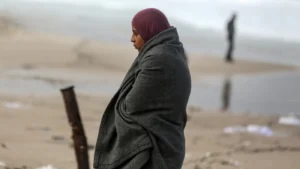Netzarim corridor: Israel’s ‘axis of death’ for Palestinians

A displaced Palestinian woman stands outside her tent, which is damaged by wind and rain, in Deir al-Balah central Gaza Strip, 25 November 2024
Ruwaida Amer reports in Middle East Eye on 24 December 2024:
Earlier this year, when a rumour spread that Palestinians could travel from southern Gaza to the north, Sabreen Lashin was one of the first to attempt to return home. But, much to her disappointment, the mother from Gaza City’s al-Shati refugee camp was blocked by Israeli forces occupying the so-called Netzarim corridor, or the “axis of death” as Palestinians refer to it.
Fed up with the miserable life of displacement she had endured in southern Gaza for a year and three months, she refused to give up. Along with five other women, she attempted to explain to the soldiers the harsh living conditions in southern Gaza. There, she had been displaced 14 times, each time seeking safety from Israeli bombardment, but to no avail. “My children can’t find work, and I can’t afford the medication I need,” the 44-year-old tells Middle East Eye. “The constant displacement, hunger, bombings, and humiliation in the south eventually pushed me to make the difficult decision to return to the north, despite the risks.”
At the checkpoint in the Netzarim corridor, some Israeli soldiers listened to her, while others remained silent. All of them rejected her pleas to return to her home. Without warning, she says, Israeli forces began shooting at people who had approached the corridor, hoping to return home.
“One of the women, a 35-year-old, was shot twice – once in the back and once below her chest,” Lashin told MEE. She clutched Lashin’s arm, pleading with her not to leave her behind for the soldiers to find. Lashin had no choice but to drag the woman back toward the south, as the others fled in fear from the sound of gunfire. As they moved, a tank rolled over the area, threatening to run over the woman. A soldier stepped out and told Lashin to leave the woman behind, but she refused. “She’s still alive,” Lashin insisted. She eventually managed to drag the woman along the road until she reached a group of young men, who helped take the wounded woman to al-Awda hospital in Nuseirat. But tragically, she did not survive.
This was one of 12 attempts Lashin made to return home in northern Gaza, and it likely won’t be the last. “Each time, I narrowly escape death, but I refuse to give up,” she says. “I keep hoping that one day the soldiers will show some mercy and let me return.”
At the Netzarim corridor, she adds, the area is filled with military jeeps and tanks, while drones hover overhead, targeting anyone who approaches.
But the risk of dying while attempting to return home is better than staying displaced in the south, she tells MEE. “I still dream of returning home,” she adds. “I want to set up a tent on the rubble of my house and live with my children, rather than enduring the humiliation of displacement in the south.”
‘An axis of death’
Lashin is one of the hundreds of thousands of internally displaced Palestinians whom Israel has been blocking from returning to their homes since the war began last year.
